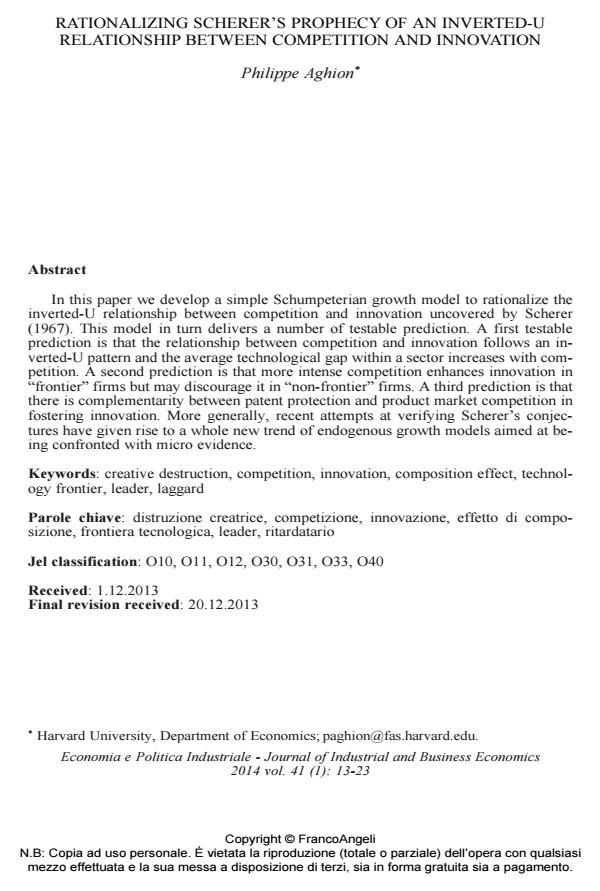Rationalizing Scherer’s prophecy of an inverted-U relationship between competition and innovation
Journal title ECONOMIA E POLITICA INDUSTRIALE
Author/s Philippe Aghion
Publishing Year 2014 Issue 2014/1 Language Italian
Pages 11 P. 13-23 File size 78 KB
DOI 10.3280/POLI2014-001002
DOI is like a bar code for intellectual property: to have more infomation
click here
Below, you can see the article first page
If you want to buy this article in PDF format, you can do it, following the instructions to buy download credits

FrancoAngeli is member of Publishers International Linking Association, Inc (PILA), a not-for-profit association which run the CrossRef service enabling links to and from online scholarly content.
In this paper we develop a simple Schumpeterian growth model to rationalize the inverted-U relationship between competition and innovation uncovered by Scherer (1967). This model in turn delivers a number of testable prediction. A first testable prediction is that the relationship between competition and innovation follows an inverted- U pattern and the average technological gap within a sector increases with competition. A second prediction is that more intense competition enhances innovation in "frontier" firms but may discourage it in "non-frontier" firms. A third prediction is that there is complementarity between patent protection and product market competition in fostering innovation. More generally, recent attempts at verifying Scherer’s conjectures have given rise to a whole new trend of endogenous growth models aimed at being confronted with micro evidence.
Keywords: Creative destruction, competition, innovation, composition effect, technology frontier, leader, laggard
Jel codes: O10, O11, O12, O30, O31, O33, O40
- Aghion P., Howitt P. 1992. a model of growth through creative destruction, Econometrica, 60 (2): 323-351, DOI: 10.2307/2951599
- Aghion P., Harris C., Vickers J. 1997. Competition and growth with step-by-step innovation: an example. European Economic Review, Papers and Proceedings, 41 (3-5): 771-782.
- Aghion P., Howitt P. 1998. Endogenous Growth Theory. Mit Press: Cambridge (Mass.).
- Aghion P., Harris C., Howitt P., Vickers J. 2001. Competition, imitation and growth with step-by-step innovation. Review of Economic Studies, 68 (3): 467-492, DOI: 10.1111/1467-937X.00177
- Aghion P., Bloom N., Blundell R., Griffith R., Howitt P. 2005. Competition and innovation: an inverted-U relationship. Quarterly Journal of Economics, 120 (2): 701-728, DOI: 10.1093/qje/120.2.701
- Aghion P., Griffith R. 2006. Competition and Growth: Reconciling Theory and Evidence. Mit Press: Cambridge (Mass.).
- Aghion P., Blundell R., Griffith R., Howitt P., Prantl S. 2009. The effects of entry on incumbent innovation and productivity. Review of Economics and Statistics, 91 (1): 20-32, DOI: 10.1162/rest.91.1.20
- Aghion P., Howitt P. 2009. The Economics of Growth. Mit Press: Cambridge (Mass.).
- Aghion P., Howitt P., Prantl S. 2012. Patent protection, product market reforms and innovative investments, mimeo.
- Aghion P., Bechtold S., Cassar L., Herz H. 2013. The effect of competition on innovation: experimental evidence, mimeo.
- Blundell R., Griffith R, Van Reenen J. 1995. Dynamic count data models of technological innovation. Economic Journal, 105 (429): 333-344, DOI: 10.2307/2235494
- Blundell R., Griffith R, Van Reenen J. 1999. Market share, market value and innovation in a panel of British manufacturing firms. Review of Economic Studies, 66 (3): 529-554, DOI: 10.1111/1467-937X.00097
- Boldrin M., Levine D. 2008. Against Intellectual Monopoly. Cambridge University Press: New york.
- Frankel J., Romer D. 1999. Does trade cause growth?. American Economic Review, 89 (3): 379-399, DOI: 10.1257/aer.89.3.379
- Grossman G., Helpman E. 1991. Quality ladders in the theory of growth. Review of Economic Studies, 58 (1): 43-61, DOI: 10.2307/2298044
- Hall B., Jaffe A., Trajtenberg M. 2001. The NBER patent citation data file: lessons, insights and methodological tools. NBER Working Paper 8498.
- Nickell S. 1996. Competition and corporate performance. Journal of Political Economy, 104 (4): 724-746, DOI: 10.1086/262040
- Qian y. 2007. Do national patent laws stimulate domestic innovation in a global patenting environment?. Review of Economics and Statistics, 89 (3): 436-453, DOI: 10.1162/rest.89.3.436
- Romer P. 1990. Endogenous technical change. Journal of Political Economy, 98 (5): 71-102, DOI: 10.1086/261725
- Scherer F.M. 1965. Firm size, market structure, opportunity, and the output of patented inventions. American Economic Review, 55 (5): 1097-1125.
- Scherer F.M. 1967. Market structure and the employment of scientists and engineers. American Economic Review, 57 (3): 524-531
- Schmutzler A. 2010. Is competition good for innovation? a simple approach to an unresolved question. Foundations and Trends in Microeconomic Analysis, 5 (6): 355-428, DOI: 10.1561/0700000035
- How does economic policy uncertainty affect corporate green innovation? Evidence from China Shengling Zhang, Zihao Wu, Wei Dou, Yu Hao, in Journal of Environmental Planning and Management /2024 pp.1
DOI: 10.1080/09640568.2023.2286926 - History, statistics and theory: Frederic M. Scherer and modern industrial organization Giovanni B. Ramello, Francesco Silva, in ECONOMIA E POLITICA INDUSTRIALE 1/2014 pp.5
DOI: 10.3280/POLI2014-001001
Philippe Aghion, Rationalizing Scherer’s prophecy of an inverted-U relationship between competition and innovation in "ECONOMIA E POLITICA INDUSTRIALE " 1/2014, pp 13-23, DOI: 10.3280/POLI2014-001002